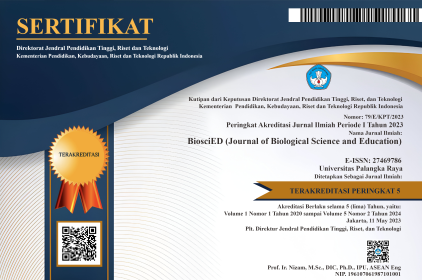Optimasi Kit Zeesan SARS-COV-2 Test Kit untuk Pengujian Deteksi DNA Porcine pada Produk Olahan Daging dan Produk Olahan Kompleks
Optimization of Zeesan SARS-COV-2 Test Kit for Porcine DNA Detection Tests on Processed Meat Products and Complex Processed Product
DOI:
https://doi.org/10.37304/bed.v3i1.4645Keywords:
Optimasi, DNA Porcine, Zeesan SARS COV-2 Test KitAbstract
Various brands of covid 19 RNA detection kits are widely used by covid 19 testing laboratories. One of these kits is the Zeesan SARS COV-2 Test Kit. The Zeesan kit cannot be used to detect porcine DNA. There has been no official research on the use of optimized covid 19 detection kits for porcine DNA detection, thus the optimization of the Zeesan SARS COV-2 Test Kit used to detect porcine DNA is a new innovation in molecular testing. The purpose of this study was to find the right combination between the Zeesan SARS COV-2 Test Kit detection kit and the porcine primer-probe. Then look for the appropriate temperature setting for the amplification process for porcine DNA testing. Analysis using Liferiver brand real-time PCR with hydrolysis probe method. The study was conducted by running 3 types of positive porcine samples with 3 different concentrations. The research sample used sausage, ham, and noodles. The results showed that the combination detection kit of Zeesan SARS COV-2 Test Kit-primary probe porcine successfully detected porcine DNA in 3 positive samples of porcine with a concentration of 10 ng and 5 ng. Meanwhile, at a concentration of 1 ng, it could only be detected in 2 positive samples. In addition, this study showed a relatively faster detection time of porcine DNA than several previous studies.
Downloads
References
Ashoor, S., Monte, W., & Stiles, P. (1998). Liquid chromatographic identification of meats. J Assoc Off Anal Chem. 71, 397-403.
Clspedes, A., Garcia, T., Cerrera, E., Gonzales, I., Fernandez, A., Hernandez, P., & Martin, R. (1999). Identification of sole (Soleasolca) and Greenland halibut (Reinhardtiushippoglossoides) by PCR amplification of the 5s rDNA gene. J Agric Food Chem.47, 1046-1050.
European Network of GMO Laboratories. (2015). Definition of Minimum Performance Requirements for Analytical Methods of GMO Testing, European Commission Joint Research Centre. Institute for Health and Consumer Protection.
Handoyo, D., & Rudiretna, A. (2001). Prinsip umum dan pelaksanaan Polymerase Chain Recation (PCR). In P. S. Bioteknologi, General Principles and Implementation of Polymerase Chain Reaction (pp. Vol. 9, No. 1 17-29). Unitas.
Jones, SI., & Paterson, R. (1985). Double antibody ELISA for detection of trace amounts of pig meat in raw meat mixtures. Meat Sci.15, 1-13.
Kim, H., & LA, S. (1986). Characterization and identification of raw beef, pork, and chicken and turkey meats by their sarcoplasmis protein electrophoretic patterns. J food Set, 51, 731-741.
Sari, F. (2017). Identifikasi Spesies Babi pada Produk Pangan Asal Hewan di Pasar Tradisional Provinsi Riau dengan metode Polymerase Chain Reaction. Jurnal Riau Biologia 2 (1), 55-60.
The sub-working group "Validation of real-time PCR methods". (2016). Guidelines for the single-laboratory validation of qualitative real-time PCR methods. Bundesamt Verbraucherschutz und Lebensmittelsicherheit (BVL).
Tom, M. R., & Mina, M. J. (2020). to Interpret the SARS Cov-2 test, consider the Cycle Threshold Value sample. Clinical Infectious Diseas, ciaa619, DDI:1.0.
Yusuf, Z. K. (2010). Polymerase Chain Reaction (PCT). Saintek.5(6).
Downloads
Published
How to Cite
Issue
Section
License
Copyright (c) 2022 Tirta Setya Bhakti

This work is licensed under a Creative Commons Attribution 4.0 International License.















